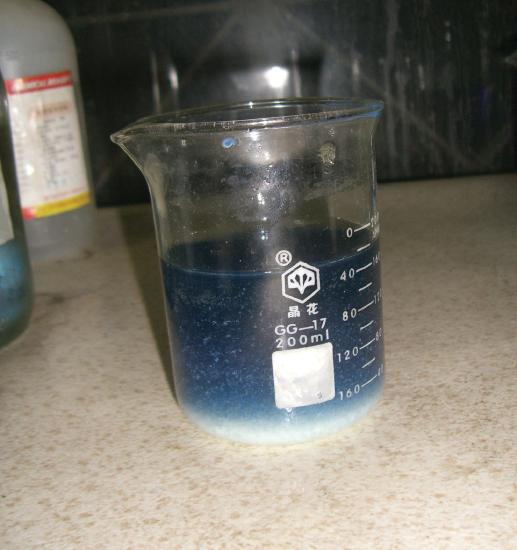5.3: Precipitation Reactions and Solubility Guidelines
- Page ID
- 86212
- Use solubility rules to predict whether a precipitate will form.
- Write and balance chemical equations for precipitation reactions.
There are many types of chemical reactions that you will learn about in chemistry. In this chapter, we will focus on some reactions of ionic compounds: precipitation reactions (a type of double-replacement reaction), acid-base neutralization reactions, and oxidation-reduction reactions.
The practice of barter (trading one thing for another) has been in existence since the beginning of time. In the past, for example, items like chickens were bartered for newspapers. Person A had something that person B wanted, and vice versa. So, when person A and person B traded items, they each had something new. Some chemical reactions are like that—compounds swap parts, and the products are new materials.
A double-replacement reaction is a reaction in which the positive and negative ions of two ionic compounds exchange places to form two new compounds. The general form of a double-replacement (also called double-displacement) reaction is:
\[\ce{AB} + \ce{CD} \rightarrow \ce{AD} + \ce{CB}\]
In this reaction, \(\ce{A}\) and \(\ce{C}\) are positively-charged cations, while \(\ce{B}\) and \(\ce{D}\) are negatively-charged anions. Double-replacement reactions generally occur between substances in aqueous solution. In order for a reaction to occur, one of the products is usually a solid precipitate, a gas, or a molecular compound such as water.
Formation of a Precipitate
A precipitate forms in a double-replacement reaction when the cations from one of the reactants combine with the anions from the other reactant to form an insoluble ionic compound. When aqueous solutions of potassium iodide and lead (II) nitrate are mixed, the following reaction occurs:
\[2 \ce{KI} \left( aq \right) + \ce{Pb(NO_3)_2} \left( aq \right) \rightarrow 2 \ce{KNO_3} \left( aq \right) + \ce{PbI_2} \left( s \right)\]
There are very strong attractive forces that occur between \(\ce{Pb^{2+}}\) and \(\ce{I^-}\) ions and the result is a brilliant yellow precipitate (see Figure \(\PageIndex{1}\) below). The other product of the reaction, potassium nitrate, remains soluble.

To judge whether double-replacement reactions will occur, we need to know what kinds of ionic compounds form precipitates. For this, we use solubility rules, which are general statements that predict which ionic compounds dissolve (are soluble) and which do not (are not soluble, or insoluble). Table \(\PageIndex{1}\) lists some general solubility rules. We need to consider each ionic compound (both the reactants and the possible products) in light of the solubility rules. If a compound is soluble, we use the (aq) label with it, indicating that it dissolves. If a compound is not soluble, we use the (s) label with it and assume that it will precipitate out of solution. If everything is soluble, then no reaction will be expected.
| These compounds generally dissolve in water (are soluble): | Exceptions: |
|---|---|
| All compounds of Li+, Na+, K+, Rb+, Cs+, and NH4+ | None |
| All compounds of NO3− and C2H3O2− | None |
| Compounds of Cl−, Br−, I− | Ag+, Hg22+, Pb2+ |
| Compounds of SO42 | Hg22+, Pb2+, Sr2+, Ba2+ |
| These compounds generally do not dissolve in water (are insoluble): | Exceptions: |
|---|---|
| Compounds of CO32− and PO43− | Compounds of Li+, Na+, K+, Rb+, Cs+, and NH4+ |
| Compounds of OH− | Compounds of Li+, Na+, K+, Rb+, Cs+, NH4+, Sr2+, and Ba2+ |
For example, consider the possible double-replacement reaction between Na2SO4 and SrCl2. The solubility rules say that all ionic sodium compounds are soluble and all ionic chloride compounds are soluble, except for Ag+, Hg22+, and Pb2+, which are not being considered here. Therefore, Na2SO4 and SrCl2 are both soluble. The possible double-replacement reaction products are NaCl and SrSO4. Are these soluble? NaCl is (by the same rule we just quoted), but what about SrSO4? Compounds of the sulfate ion are generally soluble, but Sr2+ is an exception: we expect it to be insoluble—a precipitate. Therefore, we expect a reaction to occur, and the balanced chemical equation would be:
\[\ce{Na2SO4(aq) + SrCl2(aq) → 2NaCl(aq) + SrSO4(s)}\nonumber \]
You would expect to see a visual change corresponding to SrSO4 precipitating out of solution (Figure \(\PageIndex{2}\)).

Will a precipitation reaction occur? If so, identify the products.
- Ca(NO3)2 + KBr → ?
- NaOH + FeCl2 → ?
Solution
- According to the solubility rules, both Ca(NO3)2 and KBr are soluble. Now we consider what the double-replacement products would be by switching the cations (or the anions)—namely, CaBr2 and KNO3. However, the solubility rules predict that these two substances would also be soluble, so no precipitate would form. Thus, we predict no reaction in this case.
- According to the solubility rules, both NaOH and FeCl2 are expected to be soluble. If we assume that a double-replacement reaction may occur, we need to consider the possible products, which would be NaCl and Fe(OH)2. NaCl is soluble, but, according to the solubility rules, Fe(OH)2 is not. Therefore, a reaction would occur, and Fe(OH)2(s) would precipitate out of solution. The balanced chemical equation is \[\ce{2NaOH(aq) + FeCl2(aq) → 2NaCl(aq) + Fe(OH)2(s)}\nonumber \]
\[\ce{Sr(NO3)2 + KCl → }\nonumber \]
- Answer
-
No reaction; all possible products are soluble.
Key Takeaways
- A single-replacement reaction replaces one element for another in a compound.
- The periodic table or an activity series can help predict whether single-replacement reactions occur.
- A double-replacement reaction exchanges the cations (or the anions) of two ionic compounds.
- A precipitation reaction is a double-replacement reaction in which one product is a solid precipitate.
- Solubility rules are used to predict whether some double-replacement reactions will occur.

